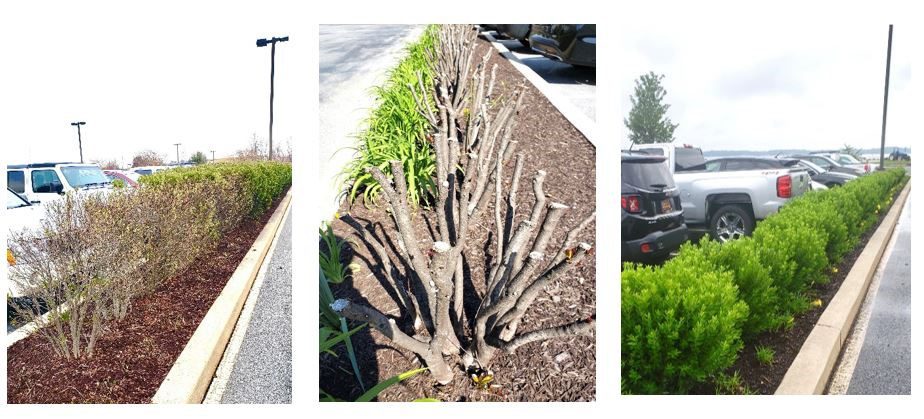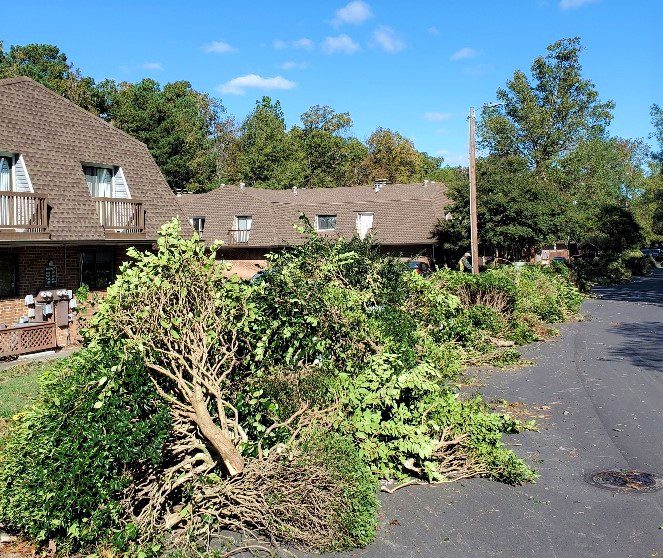 By Joe Ketterer, Director of Quality and Efficiency
By Joe Ketterer, Director of Quality and Efficiency
Rejuvenation pruning is a more severe type of pruning that is used to restore old, overgrown shrubs versus removing and replacing them. Generally speaking, the primary purpose of this type of pruning is to reduce the size of a particular plant because it has outgrown its intended living space and causes a number of potential problems if left unchecked. We most often see the need for this more labor-intensive type of pruning when we are about to sign a new contract where the existing plant material has not been properly maintained over a period of years.

Pictured L to R: (1) An Inkberry Holly suffering from a scale insect infestation is in declining health; (2) closeup of the same shrub immediately after a rejuvenation pruning; (3) regrown just six months later.
To be clear, this is not dormant pruning, which we commonly perform on many of our sites on an annual basis in order to improve and maintain general plant health and certain quality characteristics such as flowering and fruiting. Dormant pruning is much less aggressive and is typically done within the base maintenance contract dollars, whereas rejuvenation pruning is a more drastic effort to renovate existing plant material to renew the landscape at an additional cost.
Here are a few things to consider with regards to performing a rejuvenation pruning:
What variety of plant is it?
 This isn’t a one size fits all approach and some species are more amenable than others to the stress that a rejuvenation pruning can cause. Extensive knowledge and experience of plant identification and culture are key in order to be successful. Be aware that some spring or summer flowering shrubs will not bloom the year after a rejuvenation if the flower buds are set on old wood, as is the case with Oakleaf Hydrangea.
This isn’t a one size fits all approach and some species are more amenable than others to the stress that a rejuvenation pruning can cause. Extensive knowledge and experience of plant identification and culture are key in order to be successful. Be aware that some spring or summer flowering shrubs will not bloom the year after a rejuvenation if the flower buds are set on old wood, as is the case with Oakleaf Hydrangea.
Pictured right: The Oakleaf Hydrangeas seen here will have significantly reduced flowering the following summer as a result of this rejuvenation pruning.
 Other plants like certain varieties of Spirea and Abelia flower on new wood, and you can cut them to the ground, and they will grow back and flower in the same season. It is important to have a specific plan that targets certain species and be proactive in your communication with customers when performing rejuvenation pruning as there are short and long-term effects that need to be considered.
Other plants like certain varieties of Spirea and Abelia flower on new wood, and you can cut them to the ground, and they will grow back and flower in the same season. It is important to have a specific plan that targets certain species and be proactive in your communication with customers when performing rejuvenation pruning as there are short and long-term effects that need to be considered.
Pictured right: (1) An older Abelia after being repeatedly sheared; (2) Same shrub after a severe rejuvenation pruning. (3) Three months after rejuvenation pruning about to bloom; (4) Six months after a rejuvenation pruning and treatment with Trimtect growth regulator.
When is the best time to perform a rejuvenation pruning?
Timing of the operation is important and is most often best done in the dormant season (January – March) after the holidays and before mowing begins. For many varieties and especially for broadleaved evergreens, the preferred time is just before bud break in early spring versus in the dead of winter where they could be predisposed to winter burn on the foliage. However, there are a quite a few species of plants that are grown more for their foliage than for their flowering attributes (i.e. Euonymous Manhatten and Crimson Pygmy Barberry) that are very forgiving regardless of time of year. Heavily pruned shrubs will need extra care, as this practice leaves them susceptible to prevailing environmental conditions like heat, cold, wind and drought.
Why recommend this drastic cut back?
Again, this practice is generally performed on plant material that is significantly overgrown. That overgrowth may be having a negative impact on plant material that’s in close proximity, or may be causing safety and security hazards, blocking pedestrian or vehicular traffic, lighting, windows, entryways and views. This is also a good idea for aging plant material that is declining in health and may be experiencing insect or disease challenges. A rejuvenation pruning creates new growth and essentially provides a plant that was on its last legs with a new lease on life.
Are there any other considerations?
 Because of the large amount of debris that’s generated, it’s a good idea to put some thought into how you’ll dispose of all the material you’ve cut back. Does it make sense to simply load it all by hand onto our trucks and haul the material back to our production yard? Or is that task best accomplished by using a chipper (either via a rental or subcontractor) or perhaps securing a number of roll off dumpsters for bigger jobs?
Because of the large amount of debris that’s generated, it’s a good idea to put some thought into how you’ll dispose of all the material you’ve cut back. Does it make sense to simply load it all by hand onto our trucks and haul the material back to our production yard? Or is that task best accomplished by using a chipper (either via a rental or subcontractor) or perhaps securing a number of roll off dumpsters for bigger jobs?
Pictured right: Often there is a lot of debris that is generated with this type of pruning. Considering how to best remove that debris from the site should be factored into the project and proposal.
Renovating an entire site all at once may be cost prohibitive and it might be better to have a multi-year phased plan that focuses on the highest gain plant material or most problematic plants first.
In closing, I hope this article was helpful to further educate and encourage our internal and external customers to seek out these opportunities to improve the existing landscape at the point of sale by proper execution of rejuvenation pruning. Please contact me via email jketterer@ruppertcompanies.com if I can provide any additional information and recommendations about implementing this important pruning technique.
 By Joe Ketterer, Director of Quality and Efficiency
By Joe Ketterer, Director of Quality and Efficiency